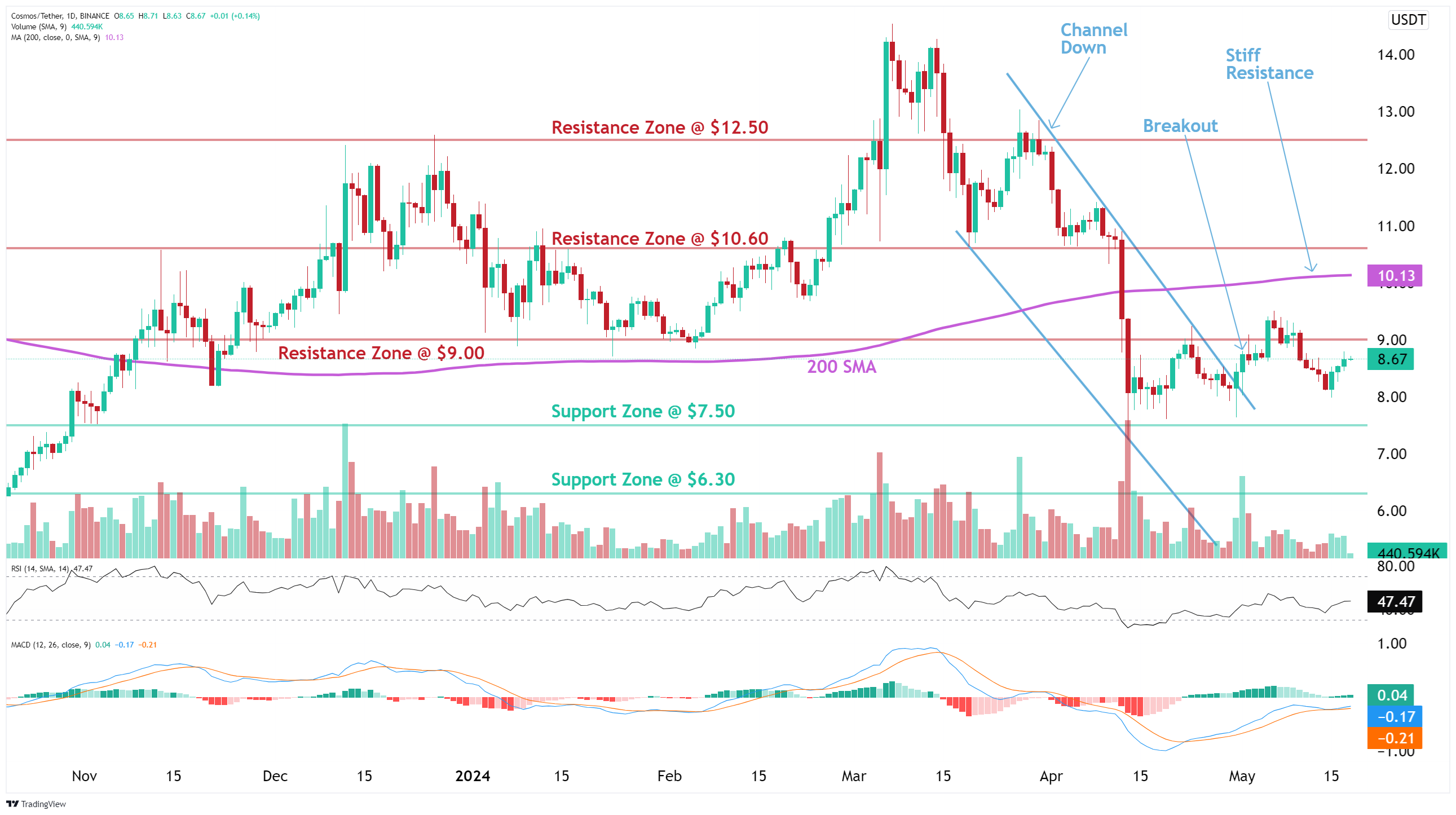Cosmos (ATOM) Analysis
Cosmos (ATOM) Analysis
In addition to automated chart patterns, altFINS’ analysts conduct technical chart analyses of top 30 cryptocurrencies. We call these Curated Charts and they evaluate 5 core principals of technical analysis: Trend, Momentum, Patterns, Volume, Support and Resistance.
Cosmos (ATOM) technical analysis:
Trade setup: Bullish breakout from a Channel Down pattern signals trend reversal with +20% upside to $10.00 (200-day moving average). Overall, price remains in a downtrend until it breaks back above that 200-day MA. (set a price alert).
Pattern: Price was trading in a Channel Down pattern. With complete patterns (i.e. a breakout) – initiate a trade when the price breaks through the channel’s trendlines, either on the upper or lower side. When this happens, the price can move rapidly in the direction of that breakout. Learn to trade chart patterns in Lesson 8.
Trend: Downtrend across all time horizons (Short- Medium- and Long-Term).
Momentum is Mixed as MACD Line is above MACD Signal Line (Bullish) but RSI ~ 50 (Neutral).
Support and Resistance: Nearest Support Zone is $7.50, then $6.30. The nearest Resistance Zone is $9.00, then $10.60, and $12.50.
See live Cosmos (ATOM) chart here
See more curated charts of coins with technical analyses.
Recent news and research:
New Cosmos (ATOM) partnership seeks to expand blockchain gaming for players worldwide
Revolut Adds ATOM, ALGO and 6 Other Assets as Users Demand Additional Crypto Offerings
Find more real-time news here.
What is Comos (ATOM)?
Find full description and news on altFINS platform.
Overview
Cosmos is a network of sovereign blockchains that communicate via IBC (Inter-Blockchain Communication), an interoperability protocol modeled after TCP/IP for secure transfer of data and value. The Cosmos Hub, also known as “Gaia,” is a Proof-of-Stake (PoS) chain with a native token, ATOM, that acts as the primary hub for routing transactions and data between blockchains within the Cosmos network. The Cosmos Hub, like the majority of blockchains in the Cosmos network, is secured by a Byzantine Fault-Tolerant (BFT) Proof-of-Stake consensus algorithm called Tendermint.
History
Cosmos aims to combine the utility of open-source software, decentralized value-transfer networks, and time-stamped blockchain data storage to accelerate the scaling, adoption, and use-case experimentation of these protocols. It views some key obstacles to these goals as status quo inefficiency, limited performance, and ad hoc governance styles. To correct these concerns, Cosmos was created as a decentralized network of independent, scalable, and interoperable blockchains, creating the foundation for a new token economy. The ideal solution, according to Cosmos, is to build a tool for interacting with multiple parallel blockchains such that the relative, unique value of a given chain’s features are exploitable on any other chain. In essence, a layered network connecting existing chains and sync activity and growth in the blockchain space. The Cosmos SDK is a developer-friendly, modular framework, each powered by a Byzantine Fault-Tolerant (BFT) consensus algorithm such as Tendermint Core, allowing developers to fully customize their decentralized applications and focus on business logic.
Technology
Cosmos is designed to operate as a network of “zones” and “hubs”. Zone simply references a network of many independent blockchains connected under Cosmos. Their interaction is powered by Tendermint Core, a secure consensus protocol easily adaptable with Proof-of-Stake (PoS) blockchains. The first Cosmos zone is called a hub, a Proof-of-Stake environment for multiple cryptocurrency assets. The hub is also able to interface with other subsequent zones via Cosmos’ inter-blockchain communication (IBC) protocol.
Usage Details
Staking, governance, and voting. Proportional claim on aggregate transation fees (can be paid in native tokens or stablecoins from connected chains).
Supply Curve Details
Atom’s targeted annual inflation rate is recalculated each block. The inflation is also subject to a rate change (positive or negative) depending on the distance from the desired staking participation ratio, currently fixed at 67%. The annual inflation is capped as between 7% and 20%. If more than ⅔ of the Atoms are being staked, atom block rewards decrease gradually down to a floor of 7% annualized inflation. If less than of the Atoms are being staked, atom block rewards increase gradually up to a ceiling of 20% annualized inflation.
Asset profile is provided by messari. Original version can be found at Messari
